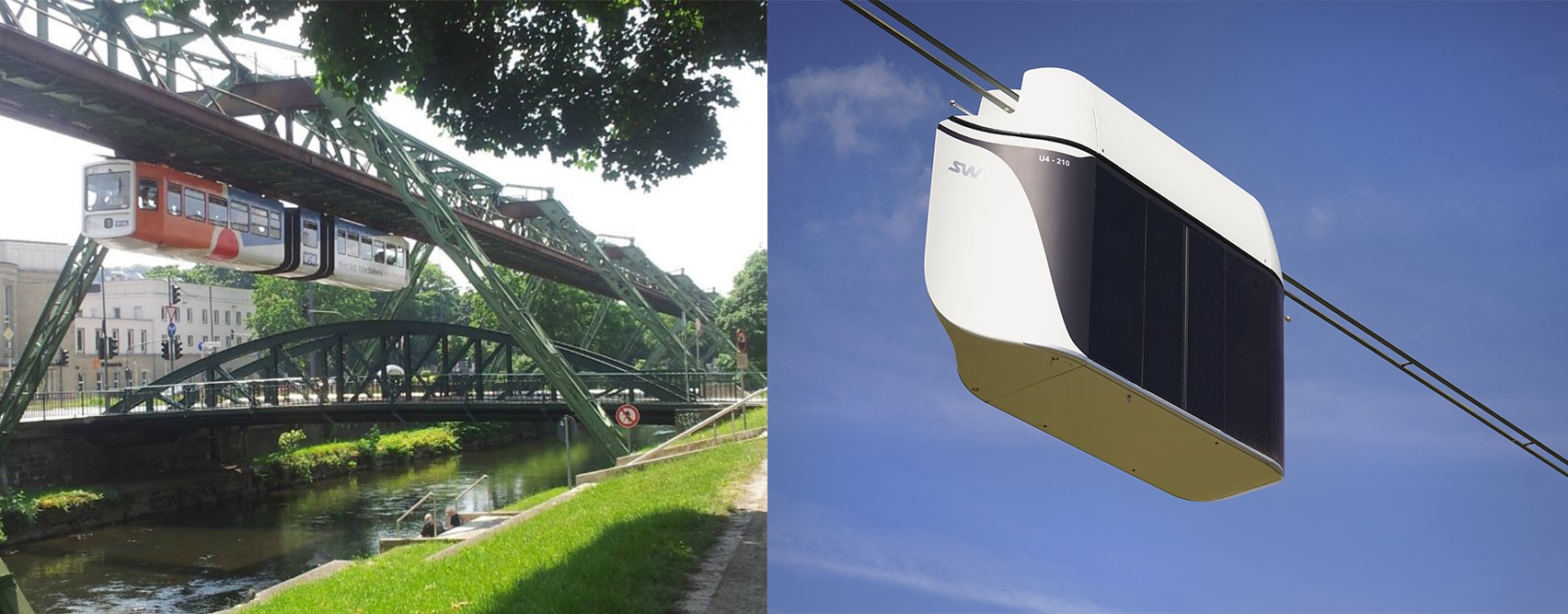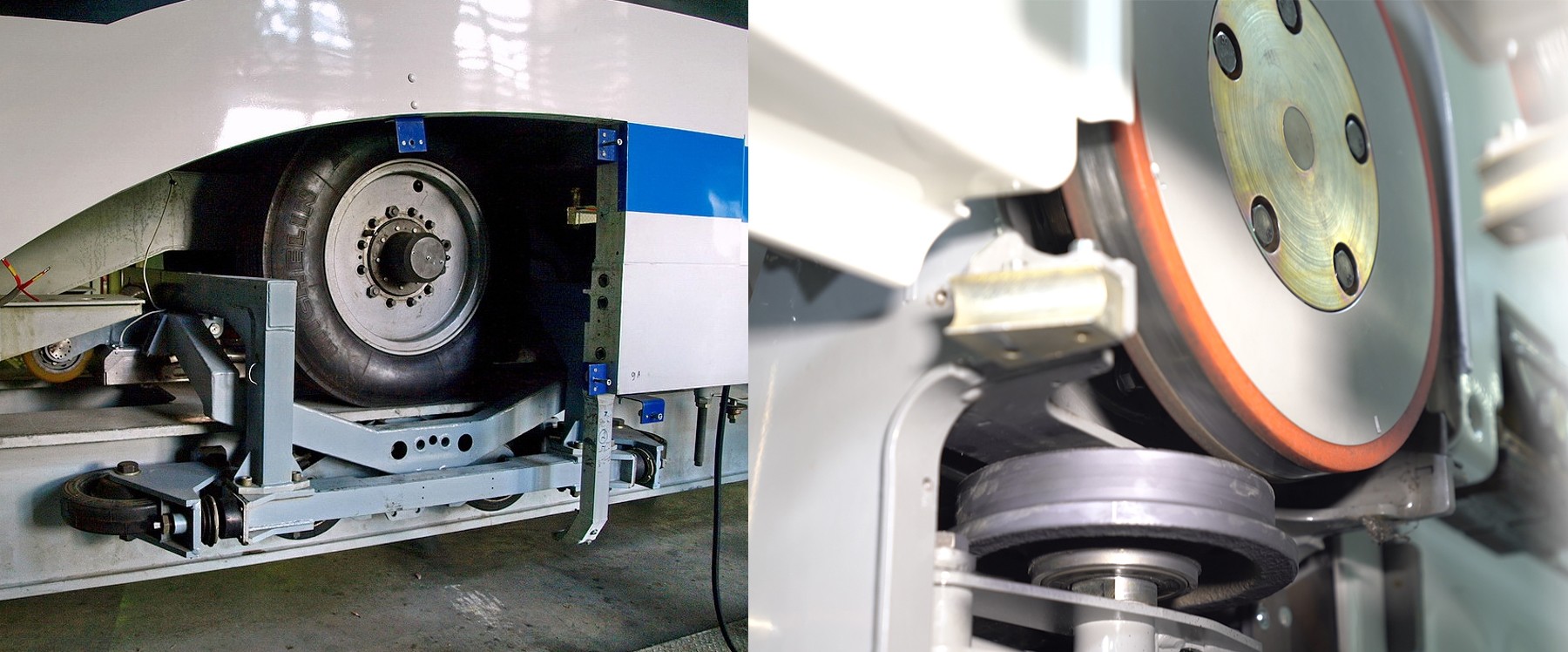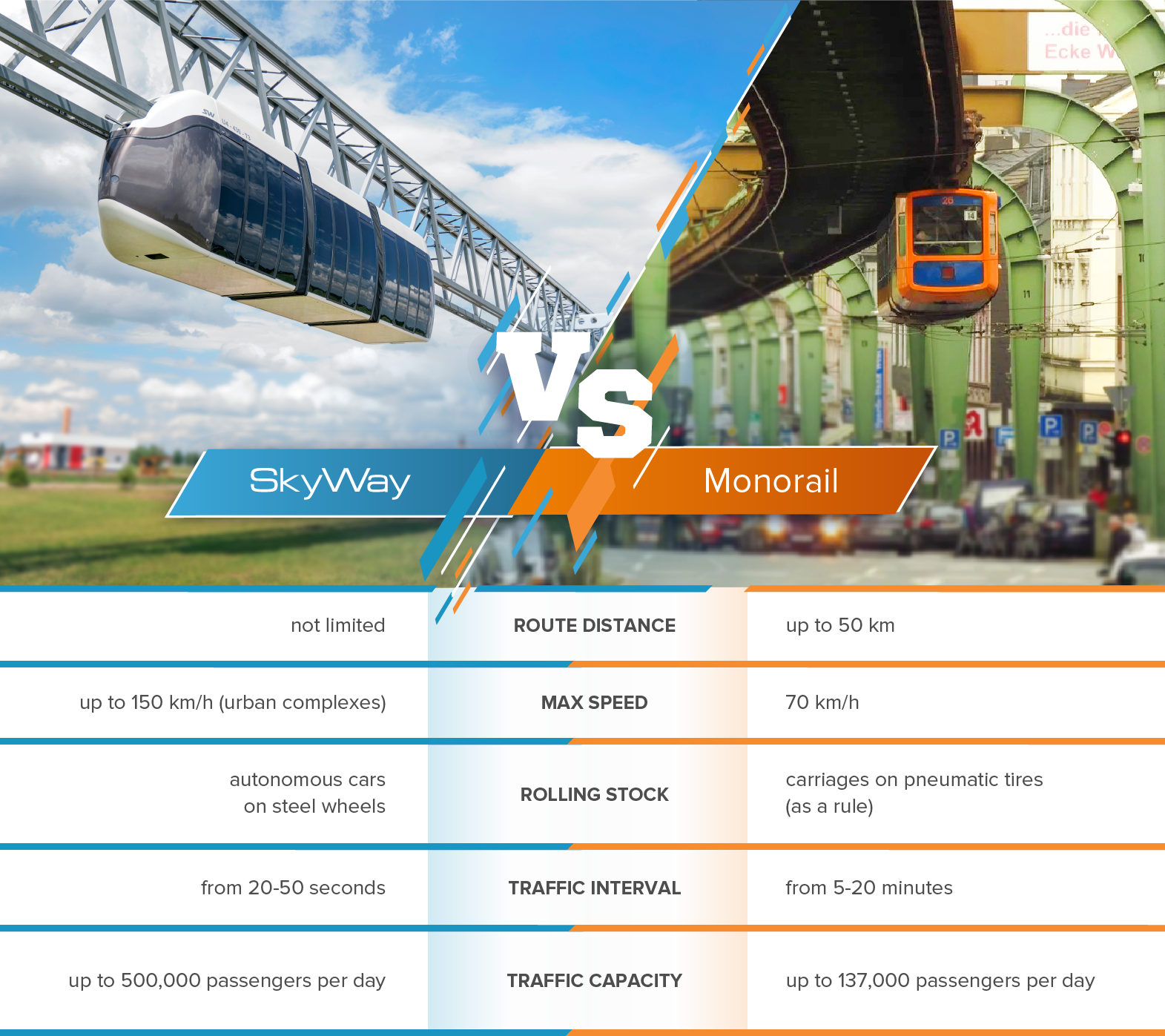

We are starting a series of publications in which we will compare SkyWay technology with existing modes of transport, analyze their features and find out how exactly SkyWay transport complexes favorably differ from the well-known and familiar ways of servicing passengers and goods, as well as what a beneficial alternative they can be.
The first article will focus on the nearest “neighbor” of SkyWay on the second level — monorail transport.
This type of transport appeared for the first time in Russia in 1820: a resident of the village Myachkovo near Moscow Ivan Elmanov has built a “road on pillars” — trolleys pulled by horses rolled on an upper longitudinal beam.

Just a year later, a monorail road was patented in England by engineer Henry Palmer, who has built its first section in 1825. Since no one in Europe knew about the project of the Russian inventor, this year became the official starting point in the history of monorail transport.
In the nearly two hundred years since Elmanov’s and Palmer’s roads were built, the world has seen dozens of monorail projects that differed in varying degrees of design and technical performance, up to the use of gyroscopes, jet engines and a magnetic cushion.
“Wuppertaler Schwebebahn” deserves a special mentioning. It is a monorail suspension road in the German city of Wuppertal that came down in history as the first monorail put into operation. It remains in operation even today servicing about 85,000 passengers per day. The line has survived two World wars and continues to make a profit, remaining a good example of a safe way to transport passengers. Perhaps the secret of Wuppertal road’s success was that it was difficult to lay a land or underground railway line in the valley of Wuppertal river in the early twentieth century, and they managed to build the monorail directly over the river.
However, Wuppertal’s experience is rather an exception to the general rule: today monorail is among the outsiders in the transport market. It would seem that an adequate idea to isolate highways by placing them above the ground, should provide a high level of safety and speed of transporting passengers and goods. But in practice, even modern types of monorails cannot boast of outstanding performance or low capital costs for construction. It often turns out expensive and inefficient.
Even high-speed Maglev, which can travel at speeds up to 600 km/h, has turned out economically unprofitable because of the high costs of construction and maintenance. Another confirmation of this is the experience of operating the Moscow monorail, which the city administration transferred to the excursion mode of operation in 2017, and then finally raised the question of the reasonability of its use due to low profitability.
The visual similarity of monorails with string transport complexes is the basis for some “experts” to estimate the market prospects of SkyWay technology. The logic of Yunitsky’s opponents is simple: the transport is externally similar, so if the monorail became unclaimed, SkyWay will repeat its fate, too. However, there is only one similar feature in these transport systems: in both cases transport is moving on a special overpass. But there are much more design differences. Anyway, let’s proceed in the right order.
A reinforced concrete or metal trestle is almost always used in monorail roads. The cost of its erection varies from 17 to 100 and more million USD per kilometer.

In string transport complexes, the overpass can withstand high loads with low material consumption due to the use of pre-stressed steel structures. This not only significantly reduces the cost of building SkyWay lines, but also provides benefits to SkyWay transport in aesthetic terms: instead of massive monorail overpasses, it is possible to build lightweight, slender and at the same time durable structures that will not look monstrous against the background of the city panorama and beyond.
Most monorail systems (except Maglev trains) use rolling stock with a running gear fitted with pneumatic tires. This solution has a number of benefits and substantial disadvantages.
The use of pneumatic tires leads to significant energy costs for motion. For example, in comparison with railway transport, energy losses can differ by 5-7 times, since pneumatic wheels have greater rolling resistance and rotation inertia in contrast to “steel wheel — rail” systems.
Theoretically, trains with pneumatic tires can overcome steeper slopes (over 15%) in contrast to rail systems. However, in practice, this advantage is insignificant, since it requires a more efficient power plant and additional energy costs that will ultimately lead to a decrease in the level of comfort for passengers.
In addition, pneumatic tires are more vulnerable to weather conditions, in particular, to the icing of track structure in winter. This requires additional cleaning of the overpass from snow and ice, or placing the running gear in an isolated box protected from rain (Safege system), which complicates its maintenance.

The design of the chassis of the SkyWay rolling stock includes a scheme in which a steel wheel rests on the rail surface. In contrast to the pneumatic tire, SkyWay wheel has low rolling resistance due to the narrow contact spot (in the rolling direction), which ensures low energy consumption by the rolling stock.
In addition, the use of the “steel wheel – rail” layout solves the problem of icing, since such a system does not need additional cleaning of the track structure. Running tests of SkyWay rolling stock at EcoTechnoPark proved it in practice.
The most commercially successful of all the traditional monorail systems are monorails produced by the Japanese company Hitachi and Canadian Bombardier. The key to their profitability was the use of ALWEG system in the structure of the running gear: two carrying wheels are on top of the rail + four supporting ones at the sides. This scheme allows to eliminate the disadvantage of low speed in a conventional monorail and helps to cope with large passenger traffic — up to 137 thousand passengers per day.
For comparison, the motion speed in urban Skyway complexes can reach 150 km/h, and, due to the use of intelligent rolling stock control systems, the theoretical peak capacity of such a system at 20-hour operation is 360 thousand people per day in one direction (taking into account a two-second allowed interval, as well as the 10-passenger base capacity of a single module). In addition, the performance of SkyWay transport complexes can be further raised by increasing the capacity of modules and combining them into trains.

We can go on comparing the two transport systems quite a long time, however, even the above points make it clear: elevated overpass transport can be different, but the structural differences between seemingly similar complexes can be very significant. So essential that one system can remain an expensive toy with very vague market prospects for as long as you want, while the other can effectively solve any existing transport problems.
This form asks for your consent to allow us to use your personal data for the reasons stated below. You should only sign it if you want to give us your consent.
Who are we?
The name of the organisation asking you for consent to use your information is:
Global Transport Investments
Trident Chambers, P.O. Box 146, Road Town
Tortola
British Virgin Islands
We would like to use the following information about you:
Why would we like to use your information?
Global Transport Investments would like to send this information to company registry, inform you about its news, for refund purposes.
What will we do with your information?
We store your name, address, ID Data, date of birth into company registry. We will share your e-mail & phone number with IT Service (https://digitalcontact.com/), SMS Center (http://smsc.ru). They will add your details to their mailing list and, when it is news update, they will send you an email or sms with details. We store your credit card number for possible refunds.
How to withdraw your consent
You can withdraw the consent you are giving on this form at any time. You can do this by writing to us at the above address, emailing us at the address: [email protected] or by clicking on the unsubscribe link at the bottom of emails you receive.
This privacy notice tells you about the information we collect from you when you sign up to receive our regular newsletter via our website. In collecting this information, we are acting as a data controller and, by law, we are required to provide you with information about us, about why and how we use your data, and about the rights you have over your data.
Who are we?
We are Global Transport Investments. Our address is Trident Chambers, P.O. Box 146, Road Town, Tortola, British Virgin Islands. You can contact us by post at the above address, by email at [email protected].
We are not required to have a data protection officer, so any enquiries about our use of your personal data should be addressed to the contact details above.
What personal data do we collect?
When you subscribe to our newsletter, we ask you for your name and your email address.
Why do we collect this information?
We will use your information to send you our newsletter, which contains information about our products.
We ask for your consent to do this, and we will only send you our newsletter for as long as you continue to consent.
What will we do with your information?
Your information is stored in our database and is shared with with IT Service (https://digitalcontact.com/), SMS Center (http://smsc.ru). It is not sent outside of the Euro. We will not use the information to make any automated decisions that might affect you.
How long do we keep your information for?
Your information is kept for as long as you continue to consent to receive our newsletter.
Your rights over your information
By law, you can ask us what information we hold about you, and you can ask us to correct it if it is inaccurate.
You can also ask for it to be erased and you can ask for us to give you a copy of the information.
You can also ask us to stop using your information – the simplest way to do this is to withdraw your consent, which you can do at any time, either by clicking the unsubscribe link at the end of any newsletter, or by emailing, writing us using the contact details above.
Your right to complain
If you have a complaint about our use of your information, you can contact the Information Commissioner’s Office.
Rate and Comment
You can assess the importance of a particular publication and the level of its preparation. Share your opinion in the comments!